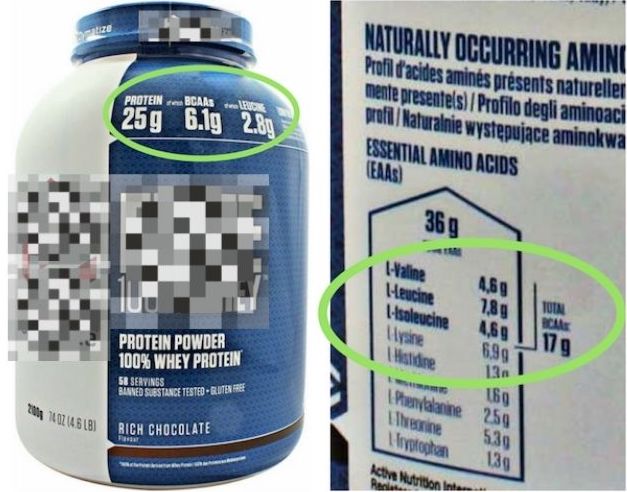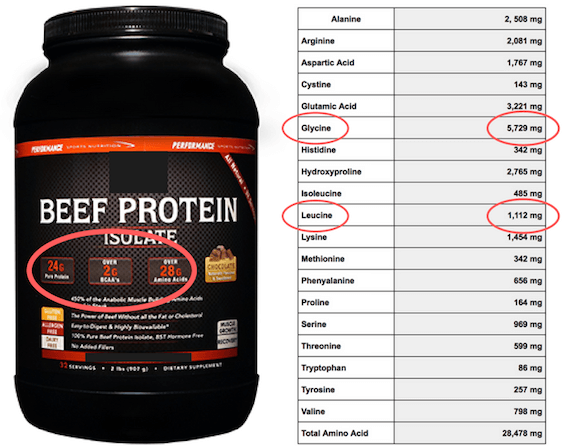What Is Protein Powder Spiking?
Supplement manufacturers sometimes dump cheap ingredients into their powders to pass tests to claim a higher protein content than they truly have, so that they can boost their profits.
This is called protein powder spiking. It’s a classic example of supplement industry bullshit.
We gym bros like protein powder. It’s a quick, convenient, and cost-effective way to hit our daily protein targets.
Whey protein is not the cheapest, but it is popular due to the high BCAA content, particularly leucine, which is critical to the muscle-building process.
Now, with consumers becoming wiser there is a rising demand for products that claim to have been lab-tested, but this comes at a time of overall rising global demand (and thus prices). Consumers are becoming sensitive to these price increases and given a lack of general education about what they should be looking for on the packet, the incentives for companies to cut costs by cheating the system are all there, and many do.
This is called ‘protein spiking’ or ‘amino spiking.’
How Amino Spiking Works
Some labs test for the nitrogen content of protein powder rather than the amounts of the individual amino acids – the building blocks of protein.
Under normal circumstances, as every amino acid contains nitrogen, measuring the nitrogen content of a powder should indicate how much protein it contains. However, this assumes that the manufacturers are honest, ha!
The first way they cheat the system is to dump cheap amino acids like glycine and taurine into the mix.
Amino acids are not all of equal value. This robs you of some of the ones that are critical to the muscle building process.
The second is to add other nitrogenous, but non-proteinogenic (protein creating) acids into the mix, such as creatine and beta-alanine.
These are cheaper by the gram, and gives the manufacturer the benefit of being able to list these on the packet, knowing that consumers have enough general awareness of these to think they are good, but not be educated enough to realize that, in fact, they are just being robbed of the protein they should be getting.
So, let’s say you are looking at a tub of protein and considering whether you should purchase it. The front of the packet advertises 25 g protein, 5 g creatine; the back label does not have the amino acids listed.
This could potentially mean that you have only 12 g of whey, with 5 g of creatine, 4 g of added glycine and 4 g of taurine added. – Without the individual amino acids listed, you simply do not know.
HOW TO CHECK PROTEIN POWDER QUALITY
Let me tell you specifically what to look out for to ensure that you are using a quality product. I’ll then show you examples of me checking a few popular powders.
Amino Acids And Other Red Flags Indicating Protein Spiking
1. It has a proprietary blend (or doesn’t list leucine content).
Proprietary blends are just a way for manufacturers to hide the quantity of the ingredients in the mix.
2. Leucine content is lower than 2.5 g per 25 g of protein content.
Whey protein is 11% leucine, so we should see ~2.7 g per 25 g of protein. This doesn’t have to be exact (you could consume a little more powder), but if it’s significantly under, this is a red flag.
(Sometimes leucine isn’t listed individually, but the BCAA content is. 25% of whey protein should be BCAAs, which is ~6.25 g per 25 g.)
3. The cost per 25 g of protein content is considerably cheaper than average.
Whey is a commodity traded on the open market. You can pay too much, but you should not ever find a powder that significantly cheaper.
I’ve seen 11x market price protein from one “luxury gym” called RIZAP in Japan which targets rich but ignorant people. They are highest on my shit-list. But you should not ever find a powder that is significantly cheaper than everything else. It’s like trying to buy cheap gold bars – if you manage to find one, it is not gold.
If your protein powder doesn’t pass these checks, you’re rolling the dice with the quality of what you’re getting and I advise you to buy something else.
EXAMPLE CHECKS WHEY, BEEF, AND VEGAN PROTEIN Products
Let’s show these principles in action by checking some popular products.
1. Whey Concentrate

You can see that there is 2.8 g of leucine listed on the front of the packet per 25 g of protein.
The leucine quantity is only listed as 7.8 g per 100 g, but this was per 100 g of powder (the whey makes up 70% of it). Dividing 7.8 by 0.7 gives us the ~11% we are after.
This product passes our quality test.
***
2. Beef Protein Isolate Sample Protein

‘Beef Protein’ appeals to consumers because the name suggests quality. But as far as I can see, this must be the only reason for the existence of this category of protein products because the quality pales in comparison to whey.
The protein that we get from meat has approximately 30% less leucine and BCAA. Powdered versions are much lower than this because the manufacturers are not creating it from the typical cuts that we like to eat, but including various parts of the animal that we don’t.
There are two red flags for this product:
- Just 2 g of BCAAs are listed (whey would give us 6.25 g).
- There are more grams of amino acids listed than protein, 28 g vs. 25 g.
This should be enough for you to rule it out of consideration. But you can see evidence of their shitfuckery on the back label:
- Glycine is 22.8% of the mix. This is very high. (Beef contains ~7% on average, whey protein a lot less.) Recall that glycine is one of the cheap filler amino acids that manufacturers use to pass the nitrogen testing for protein content.
- Hydroxyproline is in the mix. This comes from collagen, which comes from skin, bones, and tendons. This explains why the amino acid number is higher than the protein number because it is a non-proteinogenic amino acid.
This powder does not pass our quality test. I cannot recommend this product.
***
3. SunWarrior Warrior Blend Plant-based Protein

Note: The amino acids are listed per serving, each containing 19 g of protein.
Most of the vegan protein powders do not have amino acids listed. The few that do are very low quality; this is one of the exceptions.
- The leucine content is 8.6% versus whey’s 11%.
- The BCAA content (noted by the red stars) is 17.7% versus whey’s 25%.
- The essential amino acid (EAA) content is 39% (this is the red plus yellow stars) versus whey’s typical 50-60%.
- When I looked this up on Amazon US, it was 3.3x the cost of typical whey powders.
Even if you are a vegan, I don’t recommend this product. ❌ Order a custom protein blend online. A 70:30 mix of pea and rice protein closely mimics whey’s amino acid profile and should be cheaper.
Protein Spiking and Quality FAQ
I don’t make specific product recommendations, and here’s why:
1) I don’t want to be accused of bias.
2) Product formulas can (and do) change without warning.
3) I have a global audience, and product availability, pricing, and import fees vary widely.
Instead, use this guide to help you choose a quality product that meets your needs and is reasonably priced where you live.
Protein spiking is the name for the scam where supplement manufacturers dump cheap ingredients into their powders so that they can pass tests to claim a higher protein content than they truly have. Make sure you check for it when purchasing a powder, as I have outlined in this guide.
Amino spiking is also known as protein spiking. It is a scam where supplement manufacturers dump cheap amino acids (like glycine and taurine) into their powders so that they can pass tests to claim a higher protein content and make larger profits.
It’s not possible to know for sure whether your protein has been amino spiked without lab testing. However, the BCAA content of whey powder should be 25% of the total protein content, leucine should be 11%, and if there is a proprietary blend (or these things are not listed), choose another product.
The side effects of taking too much protein powder can be bloating, gas, or even constipation. There is no evidence that protein causes these issues, but some people have trouble digesting the lactose in whey, which is a dairy-based protein because they have insufficient amounts of an enzyme called lactase.
If you have this trouble, consider a non-dairy based protein. A 70:30 mix of pea and rice protein closely mimics the amino acid profile of whey. You can order custom blends from several stores online.
Whey concentrate has a slightly lower quantity of protein and typically a few more carbs per scoop, compared with isolate. Often, whey isolate isn’t worth the extra cost.
Hydrolyzed whey is similar to whey isolate, but the protein has gone through a process called “enzymatic hydrolysis,” which makes it faster to digest. It’s significantly more expensive, so unless you have less than 30 minutes between when you wake and when you lift something heavy, I wouldn’t bother.
For now, we have to assume they are not stupid enough to lie. Some independent websites test label claims though I’m not sure if any are doing so down to the amino acid level just yet. I’d go with a larger company with more to lose if caught.
Yes.
A 70:30 mix of pea and rice protein closely mimics the amino acid profile of whey. You can order custom blends from several stores online.
It varies depending on price and shipping rates to Japan.
Similar enough to whey to not have any meaningful difference.
LabDoor is a site that gives protein quality rankings. Seems good, right? Well, the site makes money off of affiliate commission. The ranking process includes factors like heavy metal contamination and claimed protein content, but it is not clear how these are weighted. Additionally, it is still unclear whether they now test for the individual amino acids, which is the only way we know if there has been amino spiking. (Probably not though, as this is far more expensive, and they don’t make a fuss about having done it.)
Whey is a powdered food source. There is no upper threshold of how much protein you should get from shakes, but you should be sensible about balancing solid food with shakes. It’s best to think of protein powders as compliments to an already varied diet – supplemental. The one serious consideration is that when you are dieting, hunger will be your enemy at some point, so it’s best to limit the calories you drink in favor of real food to help.
Thank you for reading. Questions are welcomed in the comments.
– Andy

Privacy policy.